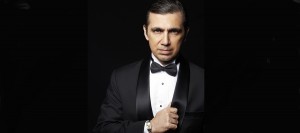PARK AVENUE’S PREEMINENT PLASTIC SURGEON REVEALS THE ART OF PERFECTION
By Lori Simmons Zelenko
Michelangelo and Dr. Ramtin Kassir have more than a passion for natural beauty of the human form in common. Sharing precision, authority and artistry they shape the body to reveal what is genuine and unique. New York’s preeminent triple board certified plastic surgeon, Dr. Kassir, is an artist himself, a sculptor of clay figures which reveal men and women without artifice. Prioritizing individuality, he is not distracted by what is trending today; balance for him is key. And so his quest then is to maintain balance between the left brain and the right brain, between the golden ratio which mathematically guides plastic surgery and the creativity that differentiates his artistry from any other surgeon.
“Individuality, a sense of uniqueness, prevails in my work,” he reveals, “there is no one nose, for example, that is right for everyone. The right nose, the artist’s choice if you will, is the one that captures the essence of the person, not a look that’s ‘owned’ by a celebrity or is fashionable at the moment.”
Dr. Kassir is particularly well known for his Ethnic Rhinoplasty procedures performed on patients of Hispanic, African American, Asian or Middle Eastern descent. “Each ethnicity has its own heritage,” he explains. “Ignoring the beauty of high cheekbones and almond eyes as we see in South American men and women, to create something more homogenous would not be aesthetically correct. To me it would not be a way to achieve ‘perfection.’” Though an element may mar the overall effect and need enhancement, such as a nose broken and twisted, or disproportionately large and jarringly masculine on a woman’s face, for Dr. Kassir ‘perfection’ is the sum of all parts and that means keeping the original character intact. “We have patients from Afghanistan to Zimbabwe so it’s important to understand and account for cultural and anatomical nuances of different ethnicities in plastic surgery. Rhinoplasty in ethnic patients requires a different approach than in Caucasian patients,” says Dr. Kassir. “While individuals vary dramatically, there are some characteristics common to the different ethnicities that can make Rhinoplasty more challenging. But underlying the wish for physical improvement is a sense that altering one’s ethnic expression can be an empowering change. However it takes skill and sensitivity to achieve a cosmetic result that beautifies the face while respecting and preserving ethnicity; race is not erased but the overall look is enhanced and of course, from the patient’s point of view, significantly improved.”
Lately there has been much buzz about Renee Zellweger’s plastic surgery. Weighing in as an authority, Dr. Kassir believes she sacrificed her uniqueness – the face that we came to know and love in movies like Bridget Jones Diary – for a comparatively conventional and eventually unrecognizable look. “Today you show a picture of her to people on the street and they have no idea who she is. It is not that the surgery was botched; it is that her character was lost,” so Kassir observes, reinforcing his point that plastic surgery needs to be in sync with all that a person represents including their ethnic heritage. He continues: “Of course, as she is an actress one has to ask what will this do to her career? Would you go see a movie with Brad Pitt if Brad Pitt did not look like Brad Pitt anymore?”
Hollywood is notorious for tinkering and tweaking and certainly Dr. Kassir has worked on his share of celebrities, models, and social elite. But his emphasis remains that no matter what the procedure, from a Botox injection (though he is an advocate of Dysport, a longer lasting alternative) to a facelift (and he does caution that cutting alone does not equal artistry; it is the intuition and creativity of the surgeon that turns ‘work’ into art), successful reinvention and rejuvenation must factor in lifestyle, location, personality and of course, ethnicity.
Different parts of the country raise different issues when it comes to plastic surgery. Dr. Kassir speaks to his own experience with a clientele that may winter in Florida and summer in the New York-New Jersey area. Although many say there is no longer a stigma about plastic surgery, and indeed attitudes have changed since the 1960s and 70s when it was so hush hush, there is a still a difference in how people choose to reveal their ‘work.’
In New York it’s hidden; dark glasses and whispers behind the menus at Le Cirque. “Patients in New York and New Jersey ask me after their nose is done, ‘how soon can I take the splint off?’,” candidly speaking Dr. Kassir notes that, “naturally my signature treatment, the 15 minute nose job is particularly popular in the Big Apple.” But in Miami and other Sunbelt destinations with a body conscious culture like California and Texas, having ‘work’ done is practically a badge of honor. As this preeminent plastic surgeon explains, “when I meet with a patient and we talk about what is right for them, I have to marry the ‘work’ to their environment and the cultural norms of the climate.”
Today surgery is not the only answer to reversing signs of aging, the primary reason Dr. Kassir finds that women – and men too – come to see him. Looking to feel vital and rejuvenated, patients may start with quick fixes with no downtime – injectables – and lasers too to firm, tighten and lift. Procedures that make a subtle difference without compromising the integrity of the individual’s original look.
Some celebrities often appearing quite drastically altered make the rounds of late night talk shows professing never to have seen a plastic surgeon. Or as a famous face or two confesses, “Oh, I’ve never had ‘work’ done, I’ve only done lasers.” This trend of euphemizing prompts Dr. Kassir to ask “Where do you draw the line? It’s OK to reveal you’ve had lasers but not surgery?” Perhaps this attitude is a reflection of the three biggest fears people have about plastic surgery. From his Park Avenue vantage point, Dr. Kassir sees these concerns falling into distinct patterns: cost as a barrier – my husband won’t approve if I spend the money, the kids need a new car, a new house, a new something; fear of anesthesia – if there is ever a time to be 100% honest with your doctor it is when you are going to have anesthesia, complications are more likely to arise from a lack of disclosure than a lack of expertise; worry about looking different – again the Renee Zellweger issue of lost individuality and before her, Michael Jackson who was the poster child for surgery that took away the beauty of ethnic origin.
But, reminds Dr. Kassir the mirror does not lie. “Look and look again. Do you see a glimpse of who you were or who you want to be? But you need help to achieve ‘perfection’? Don’t be dissuaded by others but by the same token, don’t choose a plastic surgeon who does not ‘see’ you as an artist sees a model, with clarity and realism integrating every possible consideration so that you will always be you – just a better version of yourself.” Perfection then is constant transformation for Dr. Kassir as once the work is done a more confident you emerges, ready to face the world smiling and happy, bold and beautiful and that is the rejuvenating gift of true artistry.
NIJIMA FLOATS AT THE FAIRCHILD BOTANICAL GARDEN
 Nijima floats adorn the lake inside the Fairchild Botanical Gardens in Coral Gables during Art Basel week
Nijima floats adorn the lake inside the Fairchild Botanical Gardens in Coral Gables during Art Basel week


